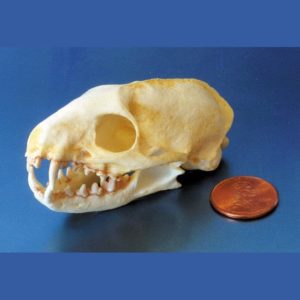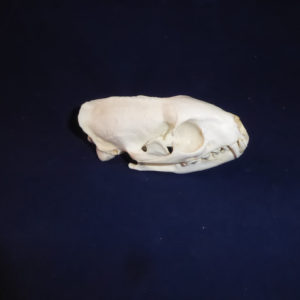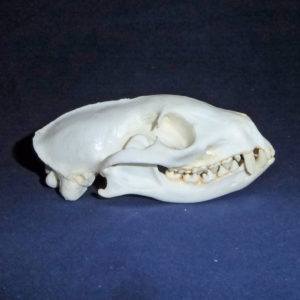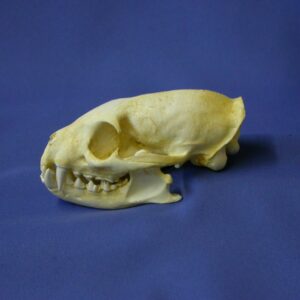Herpestidae Skull Replica measures 3.9 inches. Herpestidae Skull replica is museum quality polyurethane cast. Known as Egyptian Mongoose
The Herpestidae Family or Egyptian mongoose also known as ichneumon is a mongoose species native to the coastal regions along the Mediterranean Sea between North Africa and Turkey, tropical and subtropical grasslands, savannas, and shrublands in Africa.
The Herpestidae family or Egyptian mongoose’s long, coarse fur is grey to reddish brown and ticked with brown and yellow flecks. Its snout is pointed, its ears are small.
If excited, Egyptian mongoose can bristle its hair and arch its back to appear two times its actual size.
Herpestidae family or Egyptian mongoose’s have a period of foreplay before the animals mate. Mating lasts for almost five minutes.
During this time, the male knocks the female’s neck with his mouth wide open. The male always pursues the female. He makes a noise which the female then repeats. The females then squats and runs, this seduces the male.
Egyptian mongooses reach sexual maturity at around 2 years of age. When ready to mate the female’s vulva becomes swollen and red. Females can actually come into heat shortly after giving birth as little as ten days.
While giving birth, females stand up with their legs slightly bent. Gestation is approximately 11 weeks and litters range from 2 to 4 young which are born in July or August in Spain
A two year study of Herpestidae family or Egyptian mongooses in Donana National Park found the average group size to be anywhere from one to seven. Adults were spotted in pairs or living alone all year long.
Environmental pressures, mainly food, prevented large stable groups.
In general these animals are alert and agile. They are diurnal and are said to be very playful. However, in the wild they have also been described as extremely vicious.
They will quickly enter water and swim well. They love to bask in the morning sun.
The glands near the anus have a peculiar use; when one animal follows another, it has its nose on the anus of the leader for orientation. This behavior originates when young mongooses closely follow their mothers.
Scent markings with these same anal glands could communicate a female’s estrous condition and/or act as a marker for an individual or a pack. The instinct to chase an anal scent is so strong that when alone, an individual may put its nose under its own tail.















